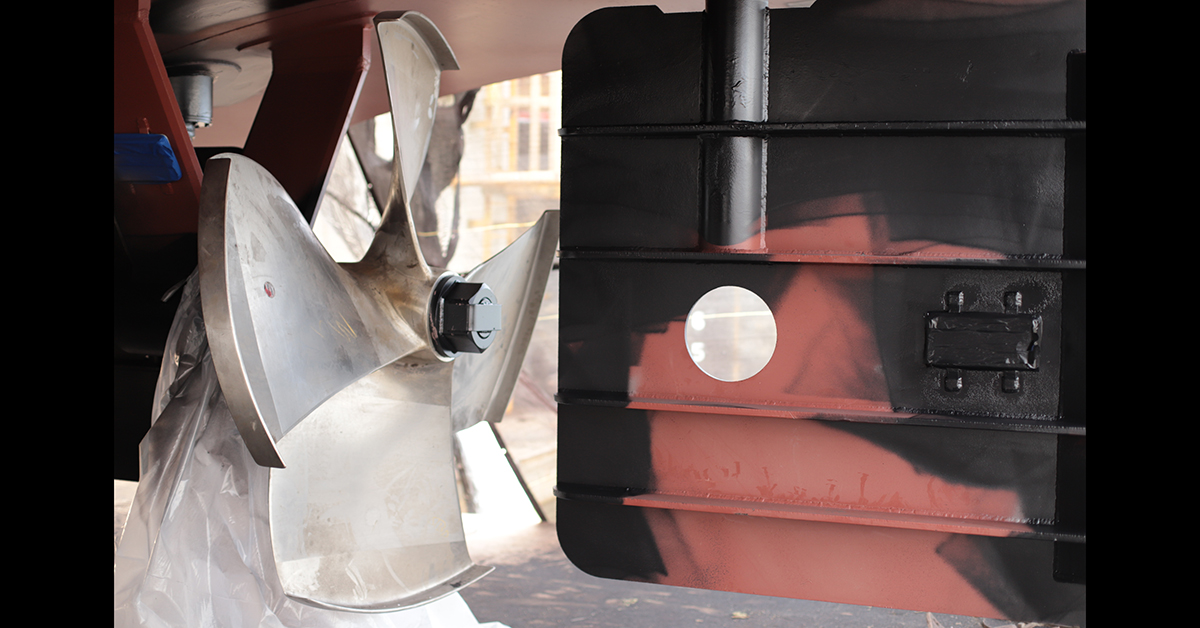HS Marine Propulsion’s new propeller design has an edge over the competition, literally.
Engineers have been working on the Edge propeller design for the better part of a decade, earning multinational patents along the way.
The design features an end plate similar to the winglet at the end of an airplane’s wing, allowing for greater loading at the outer radii of the blades without additional cavitation. It reduces the tip vortex created by the unequal pressure on the opposing side of the propeller blades as well, said Jake Travis, HS Marine Propulsion’s director of marketing.
In short, that small lip at the propeller’s edge means it produces more thrust with less cavitation, vibration and noise than a traditional propeller design, he said.
“Edge-equipped boats handle and maneuver better, with quicker response times, greater crew comfort and added efficiency that reduces fuel consumption,” the company says on an information page on its website. “Simply put, these props behave like propellers with a much larger diameter, which means more thrust. For the same horsepower, you can burn less fuel, push a larger load or get there more quickly. And you can do all this with a happier captain and crew.”
Before the Edge, commercial propeller design hadn’t changed that much over the years, Travis said. Many were based on designs from the 1940s.
Engineers at Hung Shen thought there could be a way to harness the power of propeller geometry with an improved design to produce more thrust. With the benefit of access to one of the largest testing tunnels in the world, he did just that, Travis said.
Early testing on a truckable tug equipped with standard propellers, then Edge propellers, demonstrated that what worked in the test tunnel also worked in real life.
“Our customers who use this propeller design truly do have an edge over their competitors because their boats are just so much more efficient,” Travis said.
That truckable tug, built by St. John’s Shipbuilding in Florida, saw a 7 to 27 percent increase in thrust, depending on the rpm setting.
“It was so significant we had to do it again to make sure we didn’t read something incorrectly,” Travis said.
While doing that, the team also measured other maneuvering aspects of the boat, such as crash stops and hard overs.
“Every aspect of the maneuvering of the boat was improved,” Travis said.
The first sale of the Edge propeller was for the 1,600 hp. pushboat the mv. Buckshot, which Maritime Partners built at Florida Marine Transporters’ FMT Shipyard on the Harvey Canal near New Orleans. The boat is chartered to Magnolia Fleet.
John Stewart, president of Magnolia Fleet and Magnolia Mid-Stream, said that the company quickly determined that on a route from Houston to New Orleans along the Intracoastal Canal, the Buckshot was using 200-300 gallons of fuel per day less than similar boats without the propeller.
“The wheels are definitely performing,” he said. “The Edge doesn’t allow that water to slip off the blade. It holds it and acts like a kort nozzle.”
Now in service for about 16 months, Stewart said there have been no mechanical issues with the propellers and that he regularly sees 15 to 20 percent fuel savings on any given route. He wants to see Edge propellers installed on other boats when wheels are replaced as part of normal maintenance.
Additionally, Stewart said he thinks companies will look at installing Edge propellers when refurbishing older boats to get the same kind of push power instead of larger boats with engines of more than 800 hp. each that are required to meet Tier 4 emissions standards. Tier 4 boats generally require after treatment for their exhausts and additional tankage to accommodate them, meaning they cost more to build and operate.
As a test, the company faced up the 1,600 hp. Buckshot to a 2,000 hp. boat.
“The Buckshot pushed the 2,000 hp. back,” Stewart said.
Travis said the Buckshot, moving double 30,000 bbl. tank barges, was running its route faster than the 2,000 hp. boats with conventional propellers while using less fuel.
“They’re doing the work of a 2,000 hp. boat with a 1,600,” Travis said.
Maritime Partners has now ordered eight pairs of propellers to go on eight more 1,600 hp. fleet boats. While it does cost more to manufacture the Edge propeller, Travis said, “The benefits and the efficiency gains allow for very fast return on investment.”
Chris Miller, the owner’s representative and project manager for all new construction at Maritime Partners, said the benefits of the Edge propeller are worth it from both a time and money perspective. The Buckshot is making the same route a day and a half faster than a conventionally propelled boat, he said.
“From what we’ve seen, they’re saving $300,000 plus a year in fuel savings,” he said. He added, “We’re very excited about it.”
While more research and development is still needed, “I’d really like to see us using that same propeller going up in horsepower,” Miller said. “We’ve got huge, high hopes, and we already know it’s a gamechanger in that fleet boat range.”
HS Marine Propulsion’s propellers are available in designs from 10 inches up to 160 inches in diameter and are manufactured in stainless steel and in bronze alloys.
“The same benefits apply to coastal and oceangoing boats,” Travis said. “We have focused on inland because that’s the segment of the market that has the most activity right now.”
While showing extensive benefits to traditionally “slow to medium speed” vessels, boats in the fishing fleet are now also benefitting from Edge propellers, Travis said.
Ideally, he said, HS Marine Propulsion likes to be involved from the beginning on new-build vessels.
“The earlier we’re involved in the design of the boat, the better,” he said. The company offers an engineering package for new builds in which it analyzes the hull form to optimize flow to the propellers.
HS Marine can give shipyards and operators a detailed report on how they can make the vessel more efficient, quieter and smoother.
“That’s the point where we could design an optimized Edge propeller, or other design, for that vessel,” he said.
However, Travis said it’s just as easy to install the Edge on existing boats.
“We would look at the boat’s power train and give a size recommendation and a quote for the propellers,” he said.
For more information about the Edge propeller, visit https://www.hsmarineprops.com/edge.
Featured image caption: Edge propellers from HS Marine Propulsion feature an endplate that allows for much higher loading at the outer radii of the blades without excessive cavitation. Tip vortex is also reduced. (Photo courtesy of HS Marine Propulsion)




